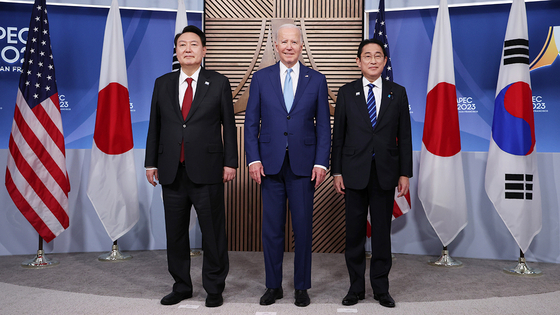How can Korea play in the new groupings?

Michael Green
The author is CEO of the U.S. Studies Centre at the University of Sydney and Henry A. Kissinger Chair at the Center for Strategic and International Studies (CSIS).
Korea has opened a new chapter in its foreign policy history with the Yoon government’s Indo-Pacific Strategy. The Park and Moon administrations were hesitant to see Asia in multipolar terms, focusing instead on how to navigate a bipolar U.S.-China competition and failing to seize opportunities with Japan, India, Australia, NATO and Asean. For the Park administration, the major play was to propose a U.S.-Korea-China trilateral, which the Obama administration passed to CSIS as a 1.5 track (think tank-led) dialogue out of deference to Japan and other allies. The aim for Seoul was leveraging China to manage North Korea, but Beijing was not prepared to play that game. The Moon administration also focused on China with a policy of “strategic ambiguity” to stay out of the growing U.S.-China competition in order to maximize opportunities for engaging North Korea. Once again Beijing was not interested — and neither was Pyongyang.
As a result of these earlier approaches, Korea fell steadily behind in the increasingly dynamic security diplomacy of the Indo-Pacific region. One problem for Seoul was that Japan was at the core of most of these new groupings and the Moon government in particular was not prepared to spend political capital on Japan that it was hoarding for big moves with North Korea. The Moon government did make some adjustments with the New Southern Policy in 2021, which was a foreign policy that followed business decisions by Samsung and others diversifying away from the China market into Southeast Asia. That allowed some more coordination with the United States on at least Southeast Asia policy. Moon also had a successful visit to Australia. But Korea was still largely playing on the margins.
That has now changed with the Yoon administration, which chose to spend political capital on rapprochement with Japan that anchored Yoon’s broader strategy to play a greater role in regional dynamics, knowing that would enhance — rather than detract from — Korea’s security on the peninsula. But Korea’s move comes late, and the Yoon administration will need to advance its strategy based on Korea’s comparative advantage in the emerging diplomatic architecture.

The core of Korea’s new regional strategy should be the U.S.-ROK-Japan trilateral commitments reached at Camp David in August. These include commitments to consult immediately in any crisis, to increase military exercises and preparation for cyberattacks, to coordinate on regional diplomacy, and to hold annual summits. The Camp David agreement locks in the two biggest U.S. alliances in Asia which will enhance deterrence on the peninsula and the influence of all three countries on diplomatic developments elsewhere in the region.
Korea should also prioritize Australia. Australia’s new Defence Strategic Review essentially concludes that Australia is now on the front lines of geopolitical friction in Asia the way Korea has been for almost eight decades. Australian officers are also integrated in U.S. military commands across the region, with key positions in the UN Command on the peninsula. And like Korea, Australia is far more dependent on China for trade than either the United States or Japan. These factors should make for a natural strategic alignment among two middle powers with close alliance and economic ties to the United States.
Evidence of the potential to anchor Indo-Pacific strategy in Australia is clear. The Korean detachment at Australia’s August 2023 Talisman Sabre exercise was the largest ever and featured live fire demonstrations by the K-9 self-propelled “Thunder” howitzer made by Hanwha. Australia has two major defense initiatives that could include Korea at some point. The first is Aukus, the Australia-UK-U.S. trilateral agreement to build nuclear powered attack submarines for Australia (Pillar One) and to develop advanced capabilities together (Pillar Two). Korean participation in Pillar One is unlikely, given U.S. sensitivities around nuclear propulsion technology and assessments in Washington that Korea and Japan are better served by diesel powered submarines given proximity to North Korea or China (Australia has further to go to defend approaches to its sea lanes). Pillar Two will be enabled by exceptions for technology transfer for Australia and the UK that might prove more elusive for Korea but the technologies under development — including autonomous undersea vehicles, quantum, and hypersonics — could all be areas for parallel collaboration with Korea, Japan and NATO. Australia’s GWEO (Guided Weapons and Explosive Ordnance) initiative is another potential area for cooperation with Korea down the road, once the framework is established with the key industrial partners from the United States and Australia.
Korea is also positioned to enhance cooperation with the U.S.-Japan-Australia-India “Quad” on a case-by-case basis. There are many strategic thinkers in Korea (and in Canada, New Zealand, and other allied capitals) who would like to join the Quad. My guess is that this will prove difficult, since India prefers to keep the grouping to four in order to retain its own influence on the agenda and avoid the impression that it is joining a new Asian “NATO” (remember that India still retains a “strategic autonomy” goal that was characterized by “non-alignment” not that long ago). Nevertheless, Korea-India cooperation is expanding, and Delhi will want to see new opportunities for Korea to be associated with the Quad working groups on technology or maritime security.
Beyond the Indo-Pacific Korea can continue building on President Yoon’s participation in the NATO summit in order to ensure that on issues from technology decoupling to countering disinformation by authoritarian regimes, there is strong alignment between the Euro-Atlantic and Indo-Pacific security alliances and groupings. NATO and the EU would no doubt support Korea in the event of a crisis on the peninsula, but the real leverage Europe brings in that or any other regional crisis is on China. The fact that Europe imposed harsh sanctions on Russia was a useful demonstration to Beijing that democracies will stand together when one of them is attacked, even if there is no formal security treaty or guarantee for the country under attack. Korea’s growing defense trade with NATO countries reinforces this sense of common purpose.
Korea brings enormous tools to these and other diplomatic, security and economic groupings. Korean defense equipment is highly sought after. Korean development assistance is impactful. Korean investment across the Indo-Pacific is ubiquitous. Korea’s stand for democratic norms is more credible than most because of Korea’s own democratic transition. Had Seoul utilized these tools and embraced the new multipolarity and multilateralism that emerged seven years ago, Korea might well have become a founding member of some of the regional groupings described above. But it is not too late for Seoul to leverage those and other networks to shape regional security and thus stability on the Korean peninsula.










with the Korea JoongAng Daily
To write comments, please log in to one of the accounts.
Standards Board Policy (0/250자)